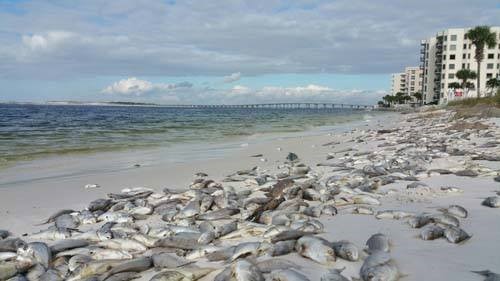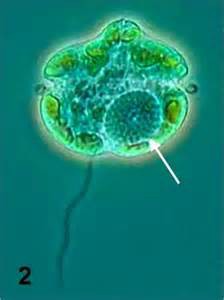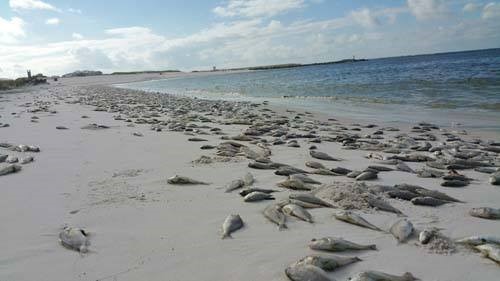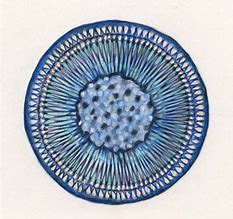
by Rick O'Connor | Nov 4, 2021
At the time of this writing, red tide is still lingering off the Pensacola coast. By the time this is posted it may or may not be. I have had a few questions about red tide while this has been occurring here, and some misconceptions about it – so, now is a good time to try and set the story straight.

The dinoflagellate Karenia brevis.
Photo: Smithsonian Marine Station-Ft. Pierce FL
Red tide is actually caused by a group of small, single-celled marine plants. The one responsible for the red tide in the Gulf of Mexico is called Karenia brevis. Karenia is a naturally occurring dinoflagellate. If I were to pull a water sample off of Pensacola Beach right now I would find it there – albeit in small concentrations – say 300-500 cells in a liter of water. At these concentrations there are no problems. When we say problems, we mean respiratory problems or fish kills. See, Karenia is a dinoflagellate that when irritated or disturbed, will release a toxin – brevotoxin. This toxin is a neurotoxin that is known to kill fish, sea turtles, and marine mammals at high concentrations – greater than 1,000,000 cells / liter. For humans the issue is more of respiratory and eye irritation. Though consuming filter feeding shellfish, such as oysters and scallops, during a red tide can cause serious gastrointestinal problems and possibly hospitalization in humans. This is why the state closes shellfish harvesting when Karenia concentrations reach 5,000 cells / liter.
What causes Karenia concentrations to increase from 500 cells to 5,000 cells, or even 1,000,000 cells / liter?
The same thing that causes all plants to grow – sunlight and nutrients.
Here is where the first misconception arises.
“Red tides are caused by the increase of nutrients in the ocean due to human activity”.
Not exactly correct. Red tides have occurred in the Gulf of Mexico since the colonial period, and the colonists certainly did not discharge enough nutrients to spawn a red tide bloom. No, these blooms occur naturally. Most form off the coast of southwest Florida. There the continental shelf extends about 200 miles offshore before reaching the slope to the deep sea. At this slope there are upwelling currents bringing nutrients from the seafloor to bath these phytoplankton in the warm Florida sun. This combination, along with some other water chemistry needs, fuel the growth of phytoplankton from a few hundred cells / liter to a few thousand, hundred thousand, or even a million cells / liter – an algal bloom. At concentrations of 1,000,000 cells or more the water actually changes color to reddish – hence the name “red tide”.
However…
Today humans ARE discharging large amounts of organic and inorganic nutrients into local waterways. These eventually make their way to the Gulf and can enhance a natural bloom from say 10,000 cells / liter to over 1,000,000 – we can make the situation worse. This typically happens when offshore winds blow the naturally occurring red tides closer to shore to meet our “cocktail of nutrients” and wa-la – an enhanced bloom with enhanced problems.

Dead fish line the beaches of the Florida Panhandle after a coast wide red tide event in October of 2015.
Photo: Randy Robinson
Here in the northern Gulf the conditions to spawn naturally occurring red tides do not typically exist. What we usually see are the blooms generated in southwest Florida pushed northward but weather patterns. At the time of this writing, Escambia County is experiencing a red tide offshore at background/very low concentrations (0-10,000 cells/liter). Though are no reports of fish kills or respiratory issues in humans, but these are happening to our east in Okaloosa, Walton, Bay, and Franklin counties.
The state is aware of the not only the red tide situation, but other harmful algal blooms occurring around the state and has a task force to try and address these. We, of course, can help by reducing the amount of nutrients (fertilizers) we discharge into our local waterways. This would include not only commercial fertilizers, but any plant and animal waste.
References
Red Tide Current Status. 2021. Florida Fish and Wildlife Conservation Commission. https://myfwc.com/research/redtide/statewide/?utm_content=&utm_medium=email&utm_name=&utm_source=govdelivery&utm_term=campaign.

by Laura Tiu | Nov 26, 2018
Red Tide has been a persistent presence in the Panhandle since September and responsible for many reported fish kills and respiratory distress in some people. Over the past week, red tide was still present in low to medium concentrations in or offshore of Escambia County to Bay County.

Jack-knife fish killed by red tide Miramar Beach, Florida
Red tide is a natural occurrence and Florida experienced red tides long before humans settled here. The tides originate 10-40 miles off shore and winds and currents bring them inshore. Red tide is fueled by nutrient typically stemming from land-based runoff.
During winter, the northerly winds and southbound currents will push the tide back offshore. There was hope that Hurricane Michael might help carry the red tide back out to sea. Unfortunately, it seems the nutrient run-off from the storm’s heavy rain or retreating storm surge may have contributed to the intensity and duration of the bloom.
In our economy, which is heavily dependent on tourism, the red tide is continuing to take a toll, especially on waterfront businesses. According to the Florida Fish and Wildlife Conservation Commission, store-bought and restaurant served shellfish are safe to eat during a red tide bloom because shellfish are monitored for safety and tested for red tide toxins before they are sold. The edible parts of crabs, shrimp and fish are not affected by the red tide organism and can be eaten, but guts should be discarded.
Many remember the local red tide bloom in 2015. The longest red tide bloom ever recorded lasted 30 months from 1994 to 1997. Warmer water due to climate change is predicted to cause algae to bloom more often, more intensely, and in more water bodies. It is imperative that we reduce nutrient inputs to our lakes, rivers, estuaries and coastal ocean waters today.

by Rick O'Connor | Sep 21, 2018
When I was in high school we were required to take a semester of communism during our senior year – the idea was to “know the enemy”. That is what we plan to do here… But, the enemy is a microscopic plant.
Its name is Karenia brevis. It is one of about 10 species of Karenia found in the ocean but it is the dominant form in the Gulf of Mexico. Karenia is referred to as “phytoplankton”, which suggests it is a microscopic plant. But in fact, it is in the Kingdom Protisita, not Plantae.

The dinoflagellate Karenia brevis.
Photo: Smithsonian Marine Station-Ft. Pierce FL
It is “plant-like” in that it has chlorophyll and can produce its own food. It differs in that it is a single cell. They are a type of phytoplankton called “dinoflagellates” because they have two flagella. The next question of course is what is flagella? It is a hair-like structure used by the cells for location. Though they can swim, they cannot out swim a current and so drift in the ocean – using their flagella to move up and down within the current and orient themselves.
The cell is covered with a protective shell called a theca, which as grooves, known as girdles, in which the flagella lie – one running east-west, the other north-south. They are between 18-45 microns long with the north-south flagella extending to look like a tail. They are members of the Gulf of Mexico community. Always out there, always have been. Typically, a plankton sample might find 1000 cells / liter. At these concentrations there does not seem to be a problem.
A problem?
What’s the problem?
The problem is that in its defense, K. brevis will release toxins. The toxin is a cocktail of lipophilic polyether compounds called brevotoxins. At low, or background concentrations, the levels of brevotoxins does not seem to effect marine organisms much at all. However, when the population of cells increases, to say 2 million / liter, fish kills can occur. The state of Florida will close shellfish harvesting if the concentrations reach 5000 / liter.
This brevotoxin is pretty strong stuff. It effects the nervous and immune systems, and effects the respiratory system. For marine vertebrates, it is deadly. At concentrations over 1,000,000 cells / liter, it can cause death for fish, dolphins, sea turtles, and manatees. Shellfish are filter feeders. During large blooms of K. brevis shellfish can consume enough to make humans very sick if they consume the shellfish.
So what causes their numbers to increase from 1000 to 1,000,000 cells / liter?
Summer…
Though K. brevis is not a plant, it is plant-like. Plants like sunlight and fertilizers. Warm shallow seas of southwest Florida are perfect. Nutrients are available in the environment and growth begins. Most blooms (large growth spurts) occur offshore. They love high salinities and not as common in our estuaries. However, they are plankton – wind and currents can move them closer to shore. During the raining season (summer) run-off from land brings with it nitrogen and phosphorus (nutrients) which can enhance a bloom. The fish kills begin, the respiratory problems for humans are annoying, and the tourist become concerned. Red tide can certainly have an impact on the local economy.
Globally, algal blooms seem to be increasing. Red tide can last a few days or a few months, each year varies. These are not exotic species; they are local Gulf residents who are finding warmer, saltier seas that they love. Algal blooms typically occur from September to February and though are common in southwest Florida, can extend across the Gulf to Texas – which the Florida panhandle is experiencing currently.
As Dr. Karl Havens mentions in his article attached, we cannot control the weather, but we can control the amount of nutrients we allow into our waterways. We should consider management practices that do just this to reduce the effects of these naturally occurring blooms.
Below are other articles from Sea Grant on this topic.
Frequently Asked Questions About the 2018 Red Tide Bloom – Betty Staugler, Florida Sea Grant
http://blogs.ifas.ufl.edu/charlotteco/2018/08/14/frequently-asked-questions-about-the-2018-red-tide-bloom/.
Understanding Florida’s Red Tide – Betty Staugler, Florida Sea Grant
https://www.flseagrant.org/news/2018/08/understanding-the-florida-red-tide/.
Watching and Waiting: Uncertainty About When the Algal Blooms Will End – Dr. Karl Haven, Florida Sea Grant
https://www.flseagrant.org/news/2018/07/watching-and-waiting-uncertainty-about-when-algae-blooms-will-end/.
REFERENCES
About Florida Red Tides. Florida Fish and Wildlife Conservation Commission. http://myfwc.com/research/redtide/general/about/.
Indian River Lagoon Species Inventory. Karenia brevis. Smithsonian Marine Station at Ft. Pierce. http://www.sms.si.edu/irlspec/Kareni_brevis.htm.
Pierce, R.H., M.S. Henry. 2008. Harmful Algal Toxins of the Florida Red Tide (Karenia brevis): natural chemical stressors in South Florida coastal ecosystems. Ecotoxicology. 17(7). Pp. 623-631. http://www.sms.si.edu/irlspec/Kareni_brevis.htm.

by Rick O'Connor | Jan 19, 2018
In the last article, we discussed what phytoplankton are, what their needs were, and their importance to marine life throughout the Gulf and coastal estuaries. In this article, we will discuss the different types of phytoplankton found in our waters.

The spherical shape of the centric diatom.
Image: Florida International University
Marine scientists interested in the diversity and abundance of phytoplankton will typically sample using a plankton net. There are a variety of different shapes and sizes of these nets, but the basic design would be funnel shaped with a sample jar attached at the small end of the funnel. The plankton net would be towed behind the research vessel at varying depths for a set period of time. All plankton collected would be analyzed via a microscope. According to the text Identifying Marine Phytoplankton (1997) there are at least 14,000 species of phytoplankton and some suggest as many as 120,000. Most of these, 12,000-100,000, are diatoms, one of five classes of marine phytoplankton. The majority of the phytoplankton fall into one of two class, the diatoms and the dinoflagellates.
Diatoms are typically single celled algae encased in a clear silica shell called a frustule. The frustule can come in a variety of shapes, with or without spines, and many resemble snowflakes – their quite beautiful. They are found in the bay and Gulf in great numbers, as many as 40,000,000 cells / cup of seawater. They are the dominate phytoplankton in colder waters and are most abundant near upwellings. These are the “grasses of the sea” and the base of many marine food webs. When diatoms die, their silica shells sink to the seafloor forming layers of diatomaceous earth, which is used in filters for aquariums and oxygen mask in hospitals.
Dinoflagellates differ from diatoms in that they produce two flagella, small hair-like projections from the algae that are used for generating water currents and movement. Their shells are not silica but layers of membranes and are called thecas. Some membranes are empty and others contain different types of polysaccharides. Dinoflagellates are more abundant than diatoms in warmer waters. There are about 2000 species of them. One type, Noctiluca, are responsible for what locals call “phosphorus” or bioluminescence. These dinoflagellates produce a blue-ish light when disturbed. Many see this when walking the beach at night. Their footprints glow for a few seconds. At night, boaters can see this as their prop wash turns the dinoflagellates in the water column. The bioluminescence is more pronounced in the warm summer months and is believed to be defense against predation. The light is referred to as “cool” light in that the majority of the energy is used in producing light, not lost as heat as with typical incandescent bulbs – hence the birth of the LED light industry.

The dinoflagellate Karenia brevis.
Photo: Smithsonian Marine Station-Ft. Pierce FL
Several dinoflagellates produce toxins as a defense. Some generate what we call red tides. In the Gulf of Mexico, Karenia brevis is the species most responsible for red tide. Red tides typical form offshore and are blown into coastal areas via wind and currents. They are common off the coast of southwest Florida but occur occasionally in the panhandle. Many local red tides are actually formed in southwest Florida and pushed northward via currents. Red tides are known to kill marine mammals and fish, as well as closing areas for shellfish harvesting.
Like true plants, phytoplankton conduct photosynthesis. Between the diatoms and dinoflagellates, 50% of the planet’s oxygen is produced. These are truly important players in the ecology of both the open Gulf and local bays.
References
Annett, A.L., D.S. Carson, X. Crosta, A. Clarke, R.S. Ganeshram. 2010. Seasonal Progression of Diatom
Assemblages in Surface Waters of Ryder Bay, Antarctica. Polar Biology vol 33. Pp. 13-29.
Hasle, G.R., E.E. Syvertsen. 1997. Identifying Marine Phytoplankton. Academic Press Harcourt Brace and
Company. San Diego CA. edited by C.R. Tomas. Pp. 858.
Steidinger, K.A., K. Tangen. 1997. Identifying Marine Phytoplankton. Academic Press Harcourt Brace and
Company. San Diego CA. edited by C.R. Tomas. Pp. 858.

by Rick O'Connor | Dec 21, 2015
This is a question I have been asked several times in the last week. As most of you know the red tide that has been occurring off the panhandle the last few months is still around. Dead fish were reported on Pensacola Beach again the weekend of Dec 12-13 and a few people said they were having eye and throat problems. This weekend I received a call of dead fish inside the bay but the caller was not suffering from eye and throat issues. Its December… what’s going on?

The dinoflagellate Karenia brevis.
Photo: Smithsonian Marine Station-Ft. Pierce FL
Well let’s look again at what red tide is and what facilitates the bloom. Red tide is caused by small microscopic plants called dinoflagellates. Dinoflagellates, like all plants, develop defense against herbivores that may try and feed on them. A few of these dinoflagellates release toxins when disturbed as a defense. They are in the Gulf all of the time but usually in low numbers, maybe 300 cells per liter of water, and cause no problems. But when conditions favor growth and reproduction they do just that – grow and reproduce – in great numbers, maybe 3000 cells per liter. When this happens the water actually darkens with their presence and the amount of toxin they release increases due to the increase number of cells – now marine creatures other than those that feed on them are impacted by the toxin – this is a red tide.
So, what are these conditions?
Well, like all plants dinoflagellates like sunlight, warm temperatures, and nutrients (fertilizers). So you would think that these blooms would occur when most plants grow – summer… and you would be right. There is another condition that contributes and those are currents. If currents are strong it will spread the bloom and the concentrations are spread as well, lowering the concentration per liter of water and thus reducing or diminishing the red tide.
We generally have plenty of sunshine here in the panhandle – temperatures are relatively warm, though they are warmer in south Florida – and there are nutrients. Nutrients are available naturally in the Gulf but are increased when we have a lot of rain as the runoff brings nutrients from land. But remember red tides are not always the result of human pollution – they occur naturally but can be increased or extended with excess nutrients from human runoff. The currents here along the panhandle tend to keep red tides at bay most of the time – we do not see them often here, but that is not the case with southwest Florida. In the Port Charlotte area red tides are more common part of life. It is warmer, there is more agriculture and municipal nutrients entering the Gulf, and the currents there are slower/weaker than we have here.
So what is up in the panhandle this year?
Well the sun is still shining! Feels great out there actually. The water temperatures were in the upper 60’s inside Pensacola Bay this week and that is typical, but the Gulf is still in the 70’s, and that is typical as well. What is not typical is the warmer air temperatures. This will slow the temperature drop of the Gulf and allow plants to extend their non-dormant season. H2O is a polar molecule (has an electric charge) and so the molecules are bonded together like two magnets. Because of this it takes more heat (energy) to warm the water and so area waters warm at a slower rate than the air. If the air temperatures remain warm it will be longer before the Gulf cools down. These warmer temperatures may extend the red tide a bit longer. As far as nutrients, heavy rains in October and November probably supplied more food for the plants and contributed to the beginning of the tide. Currents pushed the red tide inshore where we began to experience the eye problems and fish kills. The north winds from the recent fronts passing through may generate upwellings in the Gulf. Upwellings are currents that bring water from the ocean floor to the surface, this would bring nutrients with it. So we still have sun, warm temperatures, and nutrients – and the bloom is still with us. What will reduce the problem will be wind and currents to drive it offshore… and time – the Gulf will eventually cool and the tide will be reduced. How long is anyone’s guess.
So why is it 70 degrees in December?
That is a question for another article…
You can track red tides in the panhandle by visiting http://myfwc.com/REDTIDESTATUS







